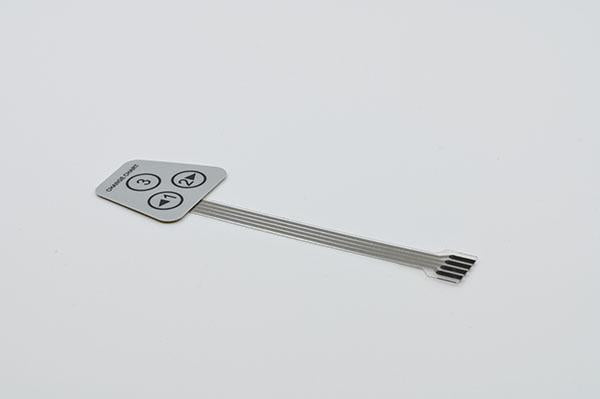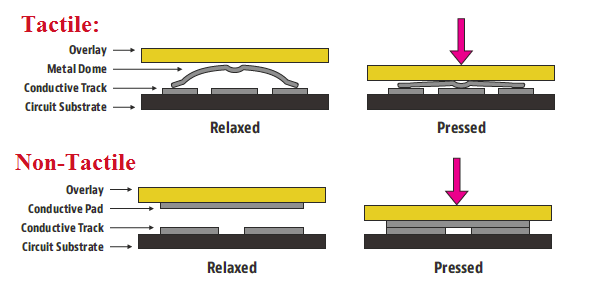Membrane Switches vs. Traditional Switches: What You Need to Know
Membrane Switches vs. Traditional Switches: What You Need to Know
Blog Article
Comprehending the Value of Membrane Switches in Interface
Membrane buttons are important components in the layout of reliable interface, promoting not only performance but additionally boosting visual appeal and user interaction. Their unique attributes, such as resistance to personalized styles and environmental factors, make them ideal for a diverse selection of applications across numerous markets. As we check out the different advantages and future patterns related to Membrane technology, it ends up being clear that these switches are a lot more than just elements; they represent a convergence of innovation and functionality. The implications of this innovation on user experience deserve examining even more.
What Are Membrane Switches?

The spacer layer, which has adhesive properties, enables the splitting up of the circuit layer from the overlay, making certain that the button continues to be in a non-activated state till pushed. When pressure is put on the overlay, it compresses the spacer layer, linking the gap and finishing the circuit in the underlying layer. This style not only reduces the physical space needed for traditional mechanical switches however likewise boosts the durability of the gadget, as Membrane switches are normally immune to dust, wetness, and other environmental factors.
Commonly found in applications varying from customer electronics to medical tools, Membrane buttons are essential to contemporary innovation, offering a efficient and straightforward interface that lines up with contemporary layout needs.
Advantages of Membrane Switches
While countless switch modern technologies exist, Membrane Switches offer unique advantages that make them particularly preferable in numerous applications. Among the main advantages of Membrane buttons is their small design, which enables space-saving implementations in devices where realty is restricted. Their slim profile not just boosts visual appeal but likewise assists in light-weight building.
Another significant advantage is their resistance to environmental aspects. Membrane switches are normally sealed versus dampness, dust, and contaminants, making them suitable for usage in demanding environments, such as medical tools and industrial equipment. This durability expands the life-span of the switch, reducing upkeep costs and enhancing dependability.
Moreover, Membrane switches can be personalized to meet certain design needs, incorporating one-of-a-kind graphics and colors that boost individual interaction. Their responsive responses choices can also be tailored to give a rewarding user experience. Furthermore, Membrane switches are affordable, especially in high-volume applications, as they can be created efficiently.
Applications in Numerous Industries

In the consumer electronics field, Membrane switches are widespread in gadgets such as microwaves, cleaning machines, and push-button controls. Their tactile comments and aesthetic options boost individual experience while offering a streamlined, modern appearance. Additionally, automotive manufacturers make use of Membrane buttons in dashboard controls and infomercial systems, where room is restricted, and individual involvement is important.
Additionally, the commercial sector leverages Membrane buttons in control panels for machinery and equipment, enabling for intuitive operation in frequently rough settings. Their resistance to chemicals and moisture ensures see here now durability and reliability in these applications. In general, the versatility of Membrane Switches contributes dramatically to their prevalent use, making them essential in numerous technological domain names.
Layout Factors To Consider for Membrane Buttons

When developing Membrane switches, a number of vital considerations have to be thought about to ensure ideal capability and customer experience. To start with, the option of materials is crucial; selecting durable, top quality substratums can boost the button's longevity and resistance to environmental factors such as dampness and temperature level variations.
Secondly, the design of the visuals overlay should focus on quality and ease of usage. Icons and message should be readable, and the design needs to facilitate user-friendly communication (membrane switches). Furthermore, tactile comments useful link is vital; including a tactile dome or other mechanisms can enhance the customer experience by giving physical confirmation of activation
Another vital factor is the switch's electric efficiency. Developers have to guarantee that the conductive traces are appropriately designed to minimize resistance and avoid signal interference. This involves assessing the needed actuation pressure and ensuring compatibility with the digital parts they will interface with.

Future Fads in Membrane Innovation
As modern technology continues to breakthrough, Membrane switches are poised to evolve significantly, driven by innovations in materials and making strategies. One emerging pattern is the incorporation of advanced products, such as conductive inks and versatile substratums, which boost sturdiness and minimize the overall weight of Membrane switches. These materials not only boost the responsive response yet additionally permit for the design of switches that can hold up against harsher ecological problems.
Additionally, the integration of touch-sensitive modern technologies is transforming standard Membrane Switches into even more interactive interface. Capacitive touch sensors installed within Membrane button panels can offer an extra my company intuitive and responsive customer experience, lining up with the expanding need for smooth, modern-day styles in consumer electronic devices.
In addition, advancements in printing techniques, such as electronic and 3D printing, allow quick prototyping and personalization of Membrane buttons. This flexibility allows makers to react faster to market needs and consumer preferences.
Lastly, sustainability is becoming a significant focus, with suppliers exploring eco-friendly products and procedures. As these fads unfold, the future of Membrane technology promises boosted functionality, aesthetic allure, and environmental obligation, solidifying their function in innovative interface throughout different markets.
Final Thought
In verdict, Membrane Switches represent a vital part in the style of customer interfaces, integrating capability with visual versatility. As improvements in technology proceed, the development of Membrane buttons is anticipated to further refine customer interfaces, driving innovation and enhancing usability in an increasingly complicated technical landscape.
Membrane switches are essential elements in the design of efficient customer interfaces, promoting not only functionality however also enhancing visual charm and user communication.Membrane Switches offer as a crucial part in different user interfaces, promoting a seamless communication in between customers and electronic gadgets.While countless button modern technologies exist, Membrane Switches offer distinct benefits that make them specifically desirable in different applications.Furthermore, Membrane buttons can be customized to meet particular design needs, integrating unique graphics and shades that improve user communication.In conclusion, Membrane Switches stand for a vital component in the style of customer interfaces, integrating performance with aesthetic flexibility.
Report this page